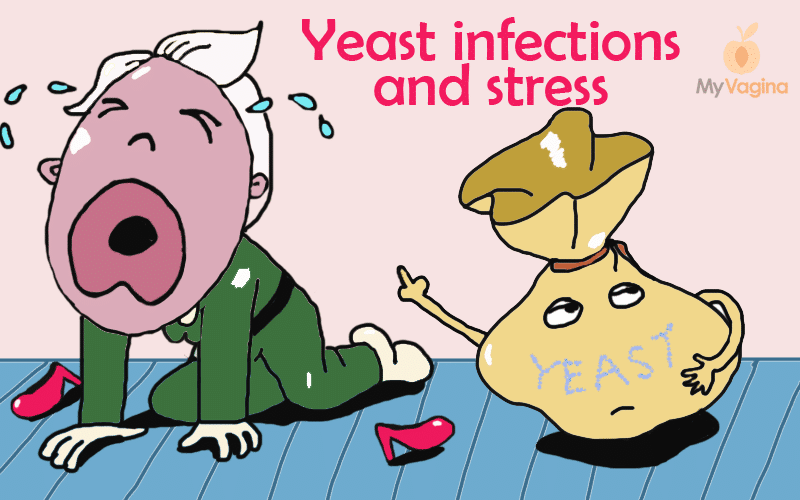Hi Aunt Vadge,
I have been having problems with recurring yeast infections for quite a while now, I’d say two years or more. I also get these little what I call “cuts” that hurt really bad. I notice the cuts and yeast infection when I’m stressed.
I’ve tried every medicine out there and nothing seems to get rid of it. I’ve been checked for STDs and it’s not that. I think it’s stress related. What do you think?
Yours,
Yeasty
Age: 19
Country: USA
____
Hi Yeasty,
Yeast infections occur because there is yeast floating around that has been allowed to overgrow. The reasons for this overgrowth are, at the core, because your body didn’t have everything it needed to defend itself, which happens a lot, paradoxically, when we are stressed and need our body to perform well.
Stress causes the production of cortisol, which causes most of your body to work differently, so that you can put your energy into whatever it is you need to do. This used to mean running away from a bear or tiger or another person, which is a short period, but now it’s school, and work, and wonky relationships, which tend to last for a long time compared to a quick sprint across an open space.
Cells divert energy and resources to your muscles while blocking important things like your cells’ natural immunity and helping your good flora thrive. You don’t need your cells to have high immunity during this sprint, but you do need cell immunity in your day-to-day life, to keep microbes out of and off your cells. Cells may have been unable to defend themselves adequately, and yeast has been allowed to get a stronghold. Stress can also contribute to urinary tract infections (UTIs).
When yeast gets a stronghold – often after a round of antibiotics – it can mean the production by yeasts of what’s known as a biofilm. This biofilm is like a protective sticky layer that acts like a shield over cells, keeping the yeast colony safe and well, but not allowing any treatments to penetrate. Additionally, this biofilm blocks the colonisation of your friendly microbes that would normally keep yeast numbers in check.
Most microbes live together in a self-regulating balanced environment. Your good bacteria fight yeast, the yeast fights your good bacteria, and they all have their little corner that they protect and serve. Yeasts are not bad; they are only bad when they become the boss of an area of your body at the expense of other healthy microbes.
When you take antibiotics or for some other reason your good bacterial colonies take a dive, whatever is left can take over, building biofilms so that later, when good microbes may wish to return, they can’t. There is no room for them to adhere, because the biofilms of other microbes have blocked the cells.
With yeast, this happens in your intestines as well as your vagina, but tends to happen more in your digestive tract where there is ample food supply and sometimes not much competition. It’s important to treat your belly to treat recurrent vaginal yeast infections, because this is where most of the yeast actually lives.
You might think your vagina and digestion are separate, but we share microbes across our entire body. Your intestines are absolutely full of all kinds of microbes, so sorting out your digestion – especially when you’re stressed – may be the key to getting rid of these opportunistic yeast infections.
Yeast will overgrow if you feed it, so possibly when you’re stressed, you eat differently or drink more. This is only natural – we look for ways to ease the stress, and this can combine with the battle of the bugs in your vagina and result in a yeast bloom that makes it to your vagina.
This means you may need to do a treatment that includes managing your digestive system instead of your vagina – your vagina, you may find, clears up by itself during this type of treatment. Not sure where to start? Try minimising (not cutting out) carbs – bread, pasta, white rice, potatoes – for a few days.
If this doesn’t help, read through our yeast biofilms page for recommendations on a more extensive treatment.
You should also follow the instructions for getting rid of a yeast infection at home, and use whichever treatments and diet changes you can afford or can.
Warmest regards,
Aunt Vadge
References1
- 1.Amabebe E, Anumba DOC. Psychosocial Stress, Cortisol Levels, and Maintenance of Vaginal Health. Front Endocrinol. Published online September 24, 2018. doi:10.3389/fendo.2018.00568

Get a fresh perspective with a qualified, experienced vulvovaginal specialist naturopath.
This product has multiple variants. The options may be chosen on the product page
The most comprehensive vaginal microbiome test you can take at home, brought to you by world-leading vaginal microbiome scientists at Juno Bio.

Promote and support a protective vaginal microbiome with tailored probiotic species.







